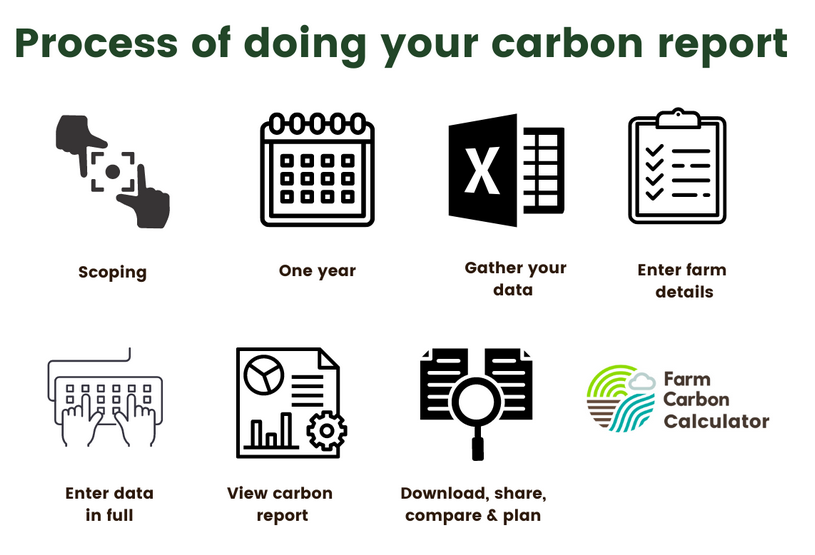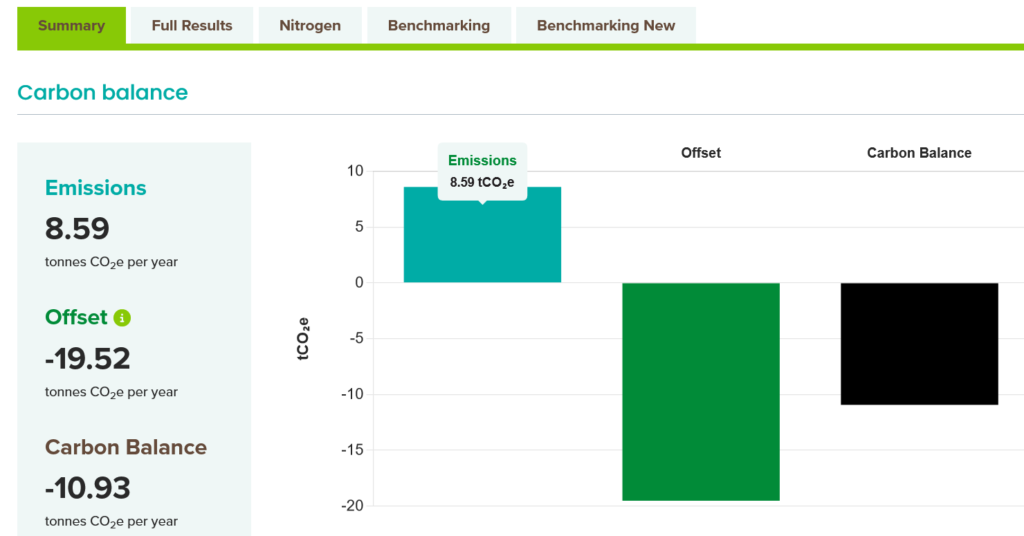
When calculating the carbon footprint of a farm business, users should expect a result that is accurate, insightful, representative and replicable. However, farmers and growers can sometimes be unsure what the results from different carbon calculators mean, and why they are different. In general, it is good practice to find a carbon calculator which works for you and stick with it. Many calculators provide their methodology which demonstrates transparency and is a feature which users should look for. In this blog we walk you through the process, and what affects the reports produced.

Inputting data into Carbon Calculators
Before starting the process of collecting data from your farm business, scoping is an important first step in understanding what’s in and what’s out of the report. For instance, a farm might have different enterprises, such as arable farming, a farm shop and some business units. Reporting on those enterprises separately makes sense from the perspective of understanding the carbon footprint of farming operations. In many instances, it is important to understand who the report is being completed for. Completing a whole farm footprint ensures that no details are overlooked and enables users to estimate farm carbon removals as well as emissions. However, increasingly the customers of farmers and growers are keen to understand the emissions associated with the products they are buying.
It should be noted, however, that producing separate reports that focus on the product can lead to overlooking important parts of a farm as a system – those parts of the farm that keep the system working but don’t directly result in a product.

Time period for the report
This is generally over a 12-month period and can coincide with business accounting or harvest year, whichever is most convenient. It is perfectly possible to carry out emissions reporting over shorter periods to coincide with, for example, batches of livestock production. If you take this approach, be sure not to leave gaps between your reporting.
Data collection is a key part of the process and is generally undertaken by the business owner/employee. Getting this right is critical, and the quality of the data going in directly affects the accuracy of the results that come out. Our advice is quite simple – collect as much data as possible that is relevant to your business over the period to be reported on. We have a data collection spreadsheet to help with this part of the process https://calculator.farmcarbontoolkit.org.uk/resources.
When entering data into the Calculator, it is important to ensure that data is entered correctly and in full. Users need to ensure that they’ve inputted everything collected in the data collection process and that units, decimal points and other important information are filled in correctly. There is much potential for error here, which will have a significant impact on the results!
Once data is entered and results can be viewed, interpretation of the report is very important. Is the report looking at a whole farm or enterprise footprint? Are you looking at the emissions only or the carbon balance? Are results being shown per hectare, per tonne, or for the whole business? Being clear about what has been measured, and what is being reported is crucial – particularly if comparing between different businesses or within a sector.
Getting our bit right
As a provider of a leading carbon calculator for farmers, growers and food businesses, at Farm Carbon Calculator we take a huge amount of care in ensuring that we are getting our numbers right.
Alongside your farm data, all Calculators will have a series of formulae and emissions factors which are used to calculate the farm’s emissions. Emissions factors tell us how much greenhouse gas is released from a certain activity – for instance using a litre of diesel in a tractor. At FCT, we do this on thousands of items! We update all our emissions factors on an annual basis, and sometimes more frequently if new and credible research comes along.
Once we’ve entered the new emissions factors, which have to be backed up by rigorous and credible peer-reviewed science, we then test the Calculator to ensure that everything is working properly. This process is rigorous and any anomalies are corrected before the update goes live. We publish our methodology and references on our resources page. The next update is due in April 2024.

This ongoing process ensures that we are on top of the science, up-to-date, and maintaining a tool that users can expect to get accurate and reliable results from, in order to make informed decisions for their business.
Alongside getting the factors and formulae correct, there is increasing guidance on what needs to be included within any agricultural greenhouse gas audit and how the calculations should be completed. Examples of such guidance come from the draft Land Sector Removals guidance from GHG protocol which sets standards for how GHG accounting should be carried out and the Forest, Land and Agriculture Science (FLAG guidance) from the Science-based Targets Initiative (SBTi). At FCT, our Calculator has been analysed against the requirements of FLAG and our Calculator has been found to be well aligned with its requirements.
As an organisation that exists to help farmers and growers measure, understand and reduce their carbon footprint, we always operate in the best interests of our users which includes ensuring our Calculator is as accurate as possible at all times. We are independent, providing a free carbon calculator for farmers and growers, and have a process of continual improvement in place. As a regular user of our Calculator you can always compare current and past results using the most up-to-date Calculator, allowing you to track business progress to net Zero.
You can find all you need to know about the Farm Carbon Calculator here If you need more information please contact us at [email protected] or phone us on 07541 453413
In the next blog we focus on how we get externally reviewed, and are engaged with industry and Government to improve accuracy and standards.




Recent Comments